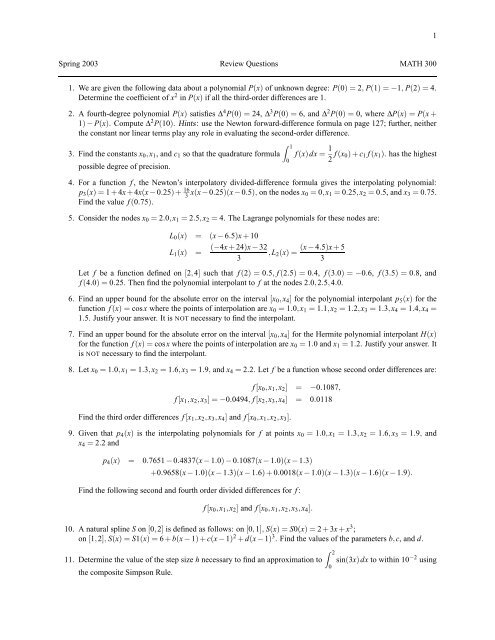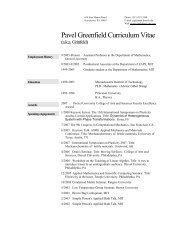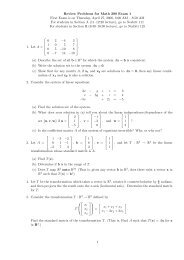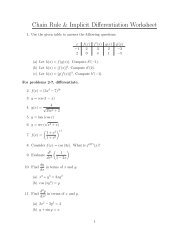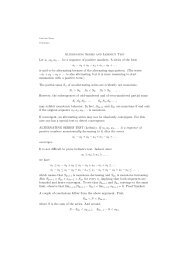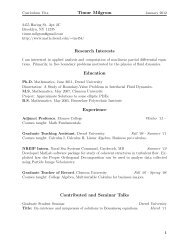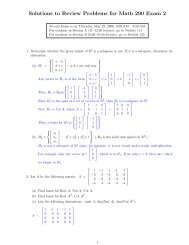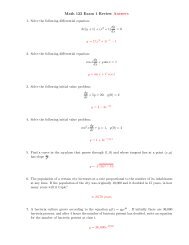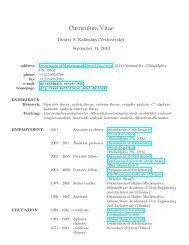Review Questions for Quiz 2
Review Questions for Quiz 2
Review Questions for Quiz 2
Create successful ePaper yourself
Turn your PDF publications into a flip-book with our unique Google optimized e-Paper software.
1Spring 2003 <strong>Review</strong> <strong>Questions</strong> MATH 3001. We are given the following data about a polynomial P(x) of unknown degree: P(0) = 2, P(1) = −1, P(2) = 4.Determine the coefficient of x 2 in P(x) if all the third-order differences are 1.2. A fourth-degree polynomial P(x) satisfies ∆ 4 P(0) = 24, ∆ 3 P(0) = 6, and ∆ 2 P(0) = 0, where ∆P(x) = P(x +1) − P(x). Compute ∆ 2 P(10). Hints: use the Newton <strong>for</strong>ward-difference <strong>for</strong>mula on page 127; further, neitherthe constant nor linear terms play any role in evaluating the second-order difference.3. Find the constants x 0 ,x 1 , and c 1 so that the quadrature <strong>for</strong>mulapossible degree of precision.∫ 10f (x)dx = 1 2 f (x 0) + c 1 f (x 1 ). has the highest4. For a function f , the Newton’s interpolatory divided-difference <strong>for</strong>mula gives the interpolating polynomial:p 3 (x) = 1 + 4x + 4x(x − 0.25) + 16 3 x(x − 0.25)(x − 0.5), on the nodes x 0 = 0,x 1 = 0.25,x 2 = 0.5, and x 3 = 0.75.Find the value f (0.75).5. Consider the nodes x 0 = 2.0,x 1 = 2.5,x 2 = 4. The Lagrange polynomials <strong>for</strong> these nodes are:L 0 (x) = (x − 6.5)x + 10L 1 (x) =(−4x + 24)x − 32,L 2 (x) =3(x − 4.5)x + 53Let f be a function defined on [2,4] such that f (2) = 0.5, f (2.5) = 0.4, f (3.0) = −0.6, f (3.5) = 0.8, andf (4.0) = 0.25. Then find the polynomial interpolant to f at the nodes 2.0,2.5,4.0.6. Find an upper bound <strong>for</strong> the absolute error on the interval [x 0 ,x 4 ] <strong>for</strong> the polynomial interpolant p 5 (x) <strong>for</strong> thefunction f (x) = cosx where the points of interpolation are x 0 = 1.0,x 1 = 1.1,x 2 = 1.2,x 3 = 1.3,x 4 = 1.4,x 4 =1.5. Justify your answer. It is NOT necessary to find the interpolant.7. Find an upper bound <strong>for</strong> the absolute error on the interval [x 0 ,x 4 ] <strong>for</strong> the Hermite polynomial interpolant H(x)<strong>for</strong> the function f (x) = cosx where the points of interpolation are x 0 = 1.0 and x 1 = 1.2. Justify your answer. Itis NOT necessary to find the interpolant.8. Let x 0 = 1.0,x 1 = 1.3,x 2 = 1.6,x 3 = 1.9, and x 4 = 2.2. Let f be a function whose second order differences are:f [x 0 ,x 1 ,x 2 ] = −0.1087,f [x 1 ,x 2 ,x 3 ] = −0.0494, f [x 2 ,x 3 ,x 4 ] = 0.0118Find the third order differences f [x 1 ,x 2 ,x 3 ,x 4 ] and f [x 0 ,x 1 ,x 2 ,x 3 ].9. Given that p 4 (x) is the interpolating polynomials <strong>for</strong> f at points x 0 = 1.0,x 1 = 1.3,x 2 = 1.6,x 3 = 1.9, andx 4 = 2.2 andp 4 (x) = 0.7651 − 0.4837(x − 1.0) − 0.1087(x − 1.0)(x − 1.3)+0.9658(x − 1.0)(x − 1.3)(x − 1.6) + 0.0018(x − 1.0)(x − 1.3)(x − 1.6)(x − 1.9).Find the following second and fourth order divided differences <strong>for</strong> f :f [x 0 ,x 1 ,x 2 ] and f [x 0 ,x 1 ,x 2 ,x 3 ,x 4 ].10. A natural spline S on [0,2] is defined as follows: on [0,1], S(x) = S0(x) = 2 + 3x + x 3 ;on [1,2], S(x) = S1(x) = 6 + b(x − 1) + c(x − 1) 2 + d(x − 1) 3 . Find the values of the parameters b,c, and d.11. Determine the value of the step size h necessary to find an approximation tothe composite Simpson Rule.∫ 20sin(3x)dx to within 10 −2 using
212. Find the values <strong>for</strong> the constants c 0 ,c 1 ,c 2 and x 0 so that the quadrature <strong>for</strong>mula:∫ 1has the highest possible degree of precision.0f (x)dx = a f (0) + b f (1/2) + c f (1)13. Consider the following numerical approximation <strong>for</strong> the first derivative of f (x) at x = a:f ′ (a) ∼ =f (a − 2h) − 4 f (a − h) + 3 f (a).2hFind the order of the error of this appromation in the <strong>for</strong>m of a dominant term and the order of the higher orderterms, by using a taylor series expansion. Your answer should have the <strong>for</strong>m: const · h r + O(h s ).MULTIPLE CHOICE QUESTIONS1. Suppose that L = L(h) + k 1 h + k 2 h 2 + ···. is an approximation to the value L. If Richardson’s extrapolation isapplied once we obtain the <strong>for</strong>mula where L (1) (h) = L(h/2) + a[L(h/2) − L(h)], where(a) a = 1, (b) a = 1/2, (c) a = 1/3.2. Suppose that L = L(h) + k 1 h 2 + k 2 h 4 + ···. is an approximation to the value L. If Richardson’s extrapolation isapplied twice to L(h) we obtain the <strong>for</strong>mula where L (2) (h) = L (1) (h/2) + a[L (1) (h/2) − L (1) (h)], where(a) a = 1, (b) a = 1/3, (c) a = 1/15.3. Consider the interpolating polynomial p 2 (x) <strong>for</strong> f (x) at x = 1,2,3 where p 2 (x) = 3+4(x−1)+1(x−1)(x−2).Then the value <strong>for</strong> f (3) is:(a) 5, (b) 10, (c) 13.4. Consider the two cubic polynomials: S 0 (x) = 1 + 3x + 2x 3 and S 1 (x) = 6 + 9(x − 1) + 6(x − 1) 2 + 2(x − 1) 3 . Dothey <strong>for</strong>m a natural cubic spline S(x) on the interval [0,2] where S = S 0 on [0,1] and S = S 2 on [1,2]? TRUE ORFALSE.5. Consider the data: x 0 = 0,x 1 = 1, f 0 = 1, f 1 = 1, and f 0 ′ = 3, f 1 ′ = −2. Let H(x) be the cubic polynomialsatisfying: H(x 0 ) = f 0 ,H(x 1 ) = f 1 and H ′ (x 0 ) = f 0 ′,H′ (x 1 ) = f 1 ′. Write H(x) = 1+3∗x−a∗x2 +x 3 , where thecoefficient a must be determined. Then a has the value:(a) 4, (b) −4, (c) 2.6. Let S(x) be the natural cubic spline <strong>for</strong> f (x) = e x at the nodes x 0 = 0,x 1 = 2, and x 2 = 2. Let S 1 (x) be the cubicfrom the spline on [0,1]. Then S 1 (x) is a cubic Hermite interpolating polynomial <strong>for</strong> f (x) on [0,1]. TRUE ORFALSE.


